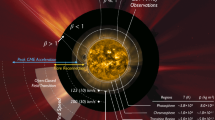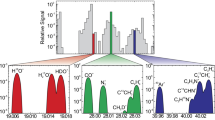Abstract
Other papers in this special issue have discussed the diversity of planetary atmospheres and some of the key science questions for giant planet atmospheres to be addressed in the future. There are crucial measurements that can only be made by orbiters of giant planets and probes dropped into their atmospheres. To help the community be more effective developers of missions and users of data products, we summarize how NASA and ESA categorize their planetary space missions, and the restrictions and requirements placed on each category. We then discuss the atmospheric goals to be addressed by currently approved giant-planet missions as well as missions likely to be considered in the next few years, such as a joint NASA/ESA Ice Giant orbiter with atmospheric probe. Our focus is on interplanetary spacecraft, but we acknowledge the crucial role to be played by ground-based and near-Earth telescopes, as well as theoretical and laboratory work.



Similar content being viewed by others
References
C.S. Arridge, C.B. Agnor, N. André et al., Uranus Pathfinder: exploring the origins and evolution of Ice Giant planets. Exp. Astron. 33, 753 (2012). https://doi.org/10.1007/s10686-011-9251-4
C.S. Arridge, N. Achilleos, J. Agarwal et al., The science case for an orbital mission to Uranus: exploring the origins and evolution of ice giant planets. Planet. Space Sci. 104, 122 (2014). https://doi.org/10.1016/j.pss.2014.08.009
S.K. Atreya, A. Crida, T. Guillot, J.I. Lunine, N. Madhusudhan, O. Mousis, The origin and evolution of Saturn, with exoplanet perspective, in Saturn in the 21st Century, ed. by K. Baines, M. Flasar, N. Krupp, T. Stallard (Cambridge University Press, Cambridge, 2019), pp. 5–43
S. Bayon et al., Ice Giants CDF Study Report, ESA document CDF-187(C), report available at the following link: http://sci.esa.int/jump.cfm?oid=61307
J.F. Bell, N.M. Schneider, M.E. Brown et al., Kuiper: a discover — class observatory for outer solar system giant planets, satellites, and small bodies, in Spacecraft Reconnaissance of Asteroid and Comet Interiors, vol. 1829 (2015), p. 6043
B. Christophe, L.J. Spilker, J.D. Anderson et al., OSS (Outer Solar System): a fundamental and planetary physics mission to Neptune, Triton and the Kuiper Belt. Exp. Astron. 34, 203 (2012). https://doi.org/10.1007/s10686-012-9309-y
S.G. Edgington, L.J. Spilker, Cassini’s grand finale. Nat. Geosci. 9, 472–473 (2016)
L.N. Fletcher et al., Ice Giant Systems: the Scientific Potential of Missions to the Uranus and Neptune Systems, White Paper submitted to ESA’s Voyage 2050 Call (2019)
L. Fletcher, Y. Kaspi, A. Showman, T. Guillot, How well do we understand the belt/zone circulation of giant planet atmospheres? Space Sci. Rev. 216(2), 1–33 (2020). https://doi.org/10.1007/s11214-019-0631-9
F. Gaillard, L. Noack, M. Bouhifd, E. Furi et al., Secular evolutions in planetary degassing: source and geodynamic controls on volatile-transfers. Space Sci. Rev. (2020), this issue
O. Grasset, M.K. Dougherty, A. Coustenis et al., JUpiter ICy moons Explorer (JUICE): an ESA mission to orbit Ganymede and to characterise the Jupiter system. Planet. Space Sci. 78, 1 (2013). https://doi.org/10.1016/j.pss.2012.12.002
L.Z. Hadid, M.W. Morooka, J.-E. Wahlund, A.M. Persoon, D.J. Andrews, O. Shebanits, W.S. Kurth, E. Vigren, N.J.T. Edberg, A.F. Nagy, A.I. Eriksson, Saturn’s ionopshere: electron density altitude profiles and D ring interaction from the Cassini grand finale. Geophys. Res. Lett. 46, 9362–9369 (2018). https://doi.org/10.1029/2018GL078004.
A.R. Hendrix, et al., The NASA roadmap to ocean worlds. Astrobiology 19, 1–27 (2018). https://doi.org/10.1089/ast.2018.1955
M.D. Hofstadter, A. Austin, A.B. Chmielewski, J.A. Cutts, P. Elia, J.O. Elliott, W.E. Frazier, J.D. Hofgartner, R. Polit-Casillas, N.J. Strange, K.R. Reh, B.H. Wilcox, Ice giant missions enabled by new technologies–or–not your parent’s ice giant mission, Abstract P34C-08, in 2019 AGU Fall Meeting, San Francisco, CA, 9–13 Dec. (2019b). Available on-line at https://agu.confex.com/agu/fm19/meetingapp.cgi/Paper/607916
M. Hofstadter, A. Simon, S. Atreya, D. Banfield, J.J. Fortney, A. Hayes, M. Hedman, G. Hospodarsky, K. Mandt, A. Masters, M. Showalter, K.M. Soderlund, D. Turrini, E. Turtle, K. Reh, J. Elliott, N. Arora, A. Petropoulos, the Ice Giant Mission Study Team, Uranus and Neptune missions: a study in advance of the next planetary science decadal survey. Planet. Space Sci. 177, 104680 (2019a). https://doi.org/10.1016/j.pss.2019.06.004
R. Hueso, M. Delcroix, A. Sánchez-Lavega, S. Pedranghelu, G. Kernbauer, J. McKeon, A. Fleckstein, A. Wesley, M. Gómez-Forrellad, J.F. Rojas, J. Juaristi, Small impacts on the giant planet Jupiter. Astron. Astrophys. 617, A68 (2018). https://doi.org/10.1051/0004-6361/201832689
M.A. Janssen, J.E. Oswald, S.T. Brown et al., MWR: microwave radiometer for the Juno mission to Jupiter. Space Sci. Rev. 213, 139 (2017). https://doi.org/10.1007/s11214-017-0349-5
Y. Kaspi, E. Galanti, A.P. Showman, D.J. Stevenson, T. Guillot, L. Iess, S.J. Bolton, Comparison of the deep atmospheric dynamics of Jupiter and Saturn in light of the Juno and Cassini gravity measurements. Space Sci. Rev. (2020). https://doi.org/10.1007/s11214-020-00705-7
J. Leconte, E. Bolmont, B. Charnay, F. Forget, F. Gaillard, M. Godolt, L. Grenfell, L. Noack, H. Rauer, F. Tian, M. Turbet, Could there be exo-atmospheres drastically different from what is found in the Solar System? Space Sci. Rev. (2020), this issue
A. Masters, N. Achilleos, C.B. Agnor et al., Neptune and Triton: essential pieces of the Solar System puzzle. Planet. Space Sci. 104, 108 (2014). https://doi.org/10.1016/j.pss.2014.05.008
F. Mills, J. Moses, P. Gao, S-M. Tsai et al., The diversity of planetary atmospheric chemistry: lessons and challenges from our Solar System and extrasolar planets. Space Sci. Rev. (2020), this issue
O. Mousis, L.N. Fletcher, J.-P. Lebreton et al., Scientific rationale for Saturn’s in situ exploration. Planet. Space Sci. 104, 29 (2014). https://doi.org/10.1016/j.pss.2014.09.014
O. Mousis, D.H. Atkinson, T. Spilker et al., The Hera Saturn entry probe mission. Planet. Space Sci. 130, 80 (2016). https://doi.org/10.1016/j.pss.2015.06.020
O. Mousis, D.H. Atkinson, T. Cavalié et al., Scientific rationale for Uranus and Neptune in situ explorations. Planet. Space Sci. 155, 12 (2018). https://doi.org/10.1016/j.pss.2017.10.005
National Research Council, Vision and Voyages for Planetary Science in the Decade 2013–2022 (The National Academies Press, Washington, 2011). https://doi.org/10.17226/13117
N. Nettelmann, R. Helled, J.J. Fortney, R. Redmer, New indication for a dichotomy in the interior structure of Uranus and Neptune from the application of modified shape and rotation data. Planet. Space Sci. 77, 143–151 (2013)
J. Norwood, J. Moses, L.N. Fletcher et al., Giant planet observations with the James Webb Space Telescope. Publ. Astron. Soc. Pac. 128, 018005 (2016). https://doi.org/10.1088/1538-3873/128/959/018005
L.M. Prockter, K.L. Mitchell, C.J.A. Howett et al., Exploring Triton with trident: a discovery class mission, in Lunar and Planetary Science Conference (2019), p. 3188
R. Ramstad, S. Barabash, Do intrinsic magnetic fields protect planetary atmospheres from stellar winds? Lessons from measurements at Mars, Venus and the Earth. Space Sc. Rev. (2020), this issue
C.T. Russel, A. Coradini, U. Christensen, M.C. De Sanctis, W.C. Feldman, R. Jaumann, H.U. Keller, A.S. Konopliv, T.B. McCord, L.A. McFadden, H.Y. McSween, S. Mottola, G. Neukum, C.M. Pieters, T.H. Prettyman, C.A. Raymond, D.E. Smith, M.V. Sykes, B.G. Williams, J. Wise, M.T. Zuber, Dawn: a journey in space and time. Planet. Space Sci. 52, 465–489 (2004). https://doi.org/10.1016/j.pss.2003.06.013.
A.P. Showman, Atmospheric dynamics of warm and hot giant planets. Space Sci. Rev. (2020), this issue
A.A. Simon, S.A. Stern, M. Hofstadter, Outer Solar System Exploration: A Compelling and Unified Dual Mission Decadal Strategy for Exploring Uranus, Neptune, Triton, Dwarf Planets, and Small KBOs and Centaurs (2018). ArXiv e-prints, arXiv:1807.08769
T.R. Spilker, M. Adler, N. Arora, P.M. Beauchamp, J.A. Cutts, M.M. Munk, R.W. Powell, R.D. Braun, P.F. Wercinski, Qualitative assessment of aerocapture and applications to future missions. J. Spacecr. Rockets 56 (2018). https://doi.org/10.2514/1.A34056
D. Turrini, R. Politi, R. Peron et al., The comparative exploration of the ice giant planets with twin spacecraft: unveiling the history of our Solar System. Planet. Space Sci. 104, 93 (2014). https://doi.org/10.1016/j.pss.2014.09.005
J. Venturini, M.P. Ronco, O.M. Guilera, Setting the stage: planet formation and volatile delivery. Space Sci. Rev. (2020). https://doi.org/10.1007/s11214-020-00700-y
M.H. Wong, M. Ádámkovics, S. Benecchi et al., A dedicated space observatory for time-domain Solar System science, in AAS/Division for Planetary Sciences Meeting Abstracts (2009). DPS meeting #41, id.16.09
J.F. Zakrajsek, J.A. Hamley, T.J. Sutliff, P.W. McCallum, C.E. Sandifer, T. Bishop, M.M. McCune, D.A. Cairns-Gallimore, Radioisotope power systems program status and expectations, in 15th Int. Energy Conversion Engineering Conference (2017). https://doi.org/10.2514/6.2017-4609
Acknowledgements
Fletcher was supported by a Royal Society Research Fellowship and European Research Council Consolidator Grant (under the European Union’s Horizon 2020 research and innovation program, grant agreement No 723890) at the University of Leicester. Masters was supported by a Royal Society University Research Fellowship. Hofstadter’s work was carried out at the Jet Propulsion Laboratory, California Institute of Technology, under a contract with the National Aeronautics and Space Administration (NASA).
Author information
Authors and Affiliations
Corresponding author
Additional information
Publisher’s Note
Springer Nature remains neutral with regard to jurisdictional claims in published maps and institutional affiliations.
Understanding the Diversity of Planetary Atmospheres
Edited by François Forget, Oleg Korablev, Julia Venturini, Takeshi Imamura, Helmut Lammer and Michel Blanc
Rights and permissions
About this article
Cite this article
Hofstadter, M.D., Fletcher, L.N., Simon, A.A. et al. Future Missions to the Giant Planets that Can Advance Atmospheric Science Objectives. Space Sci Rev 216, 91 (2020). https://doi.org/10.1007/s11214-020-00710-w
Received:
Accepted:
Published:
DOI: https://doi.org/10.1007/s11214-020-00710-w




